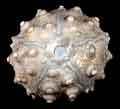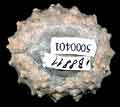The Echinoid Directory
Hemitiaris Pomel, 1883, p. 96
| Diagnostic Features |
|
|---|---|
| Distribution | Middle to Upper Jurassic (Callovian-Kimmeridgian), Europe. |
| Name gender | feminine |
| Type | Hemicidaris stramonium Agassiz, in Agassiz & Desor, 1847, p. **, by subsequent designation of Lambert & Thiery, 1910, p. 170. |
| Species Included |
|
| Classification and/or Status |
|
| Remarks | Distinguishable from Hemicidaris by having massive primary ambulacral tubercles that form a single offset column at the ambitus. |



